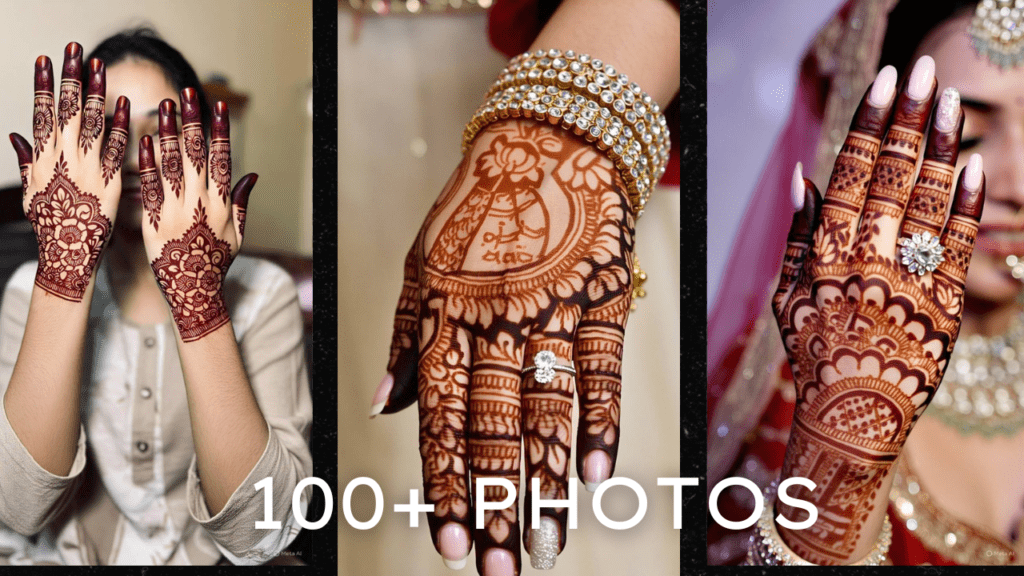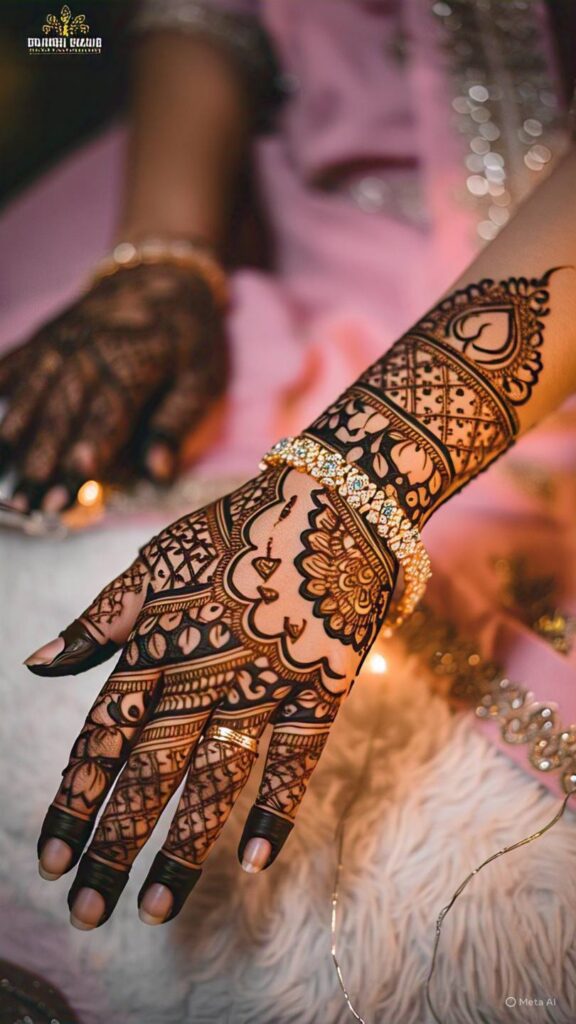
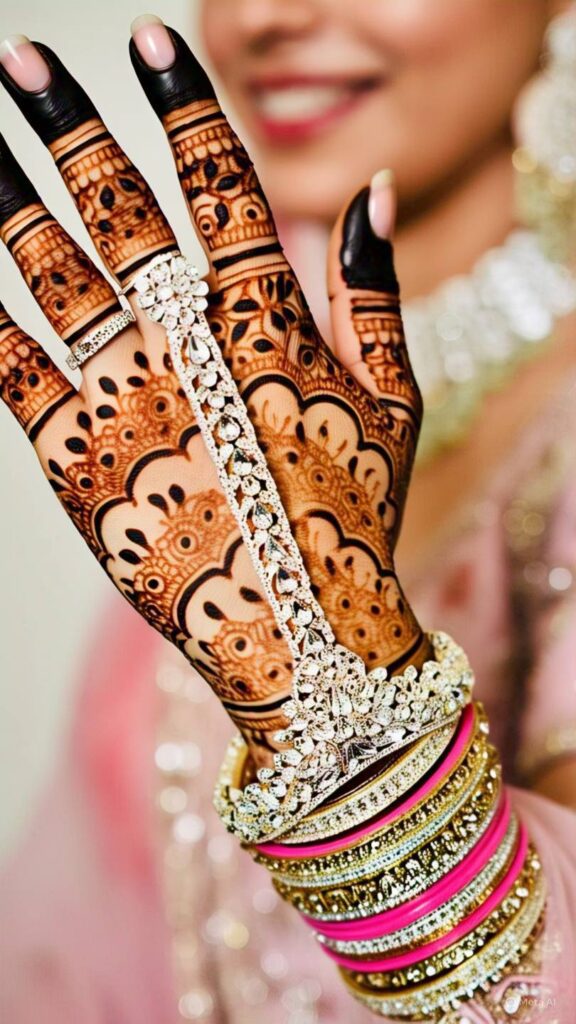
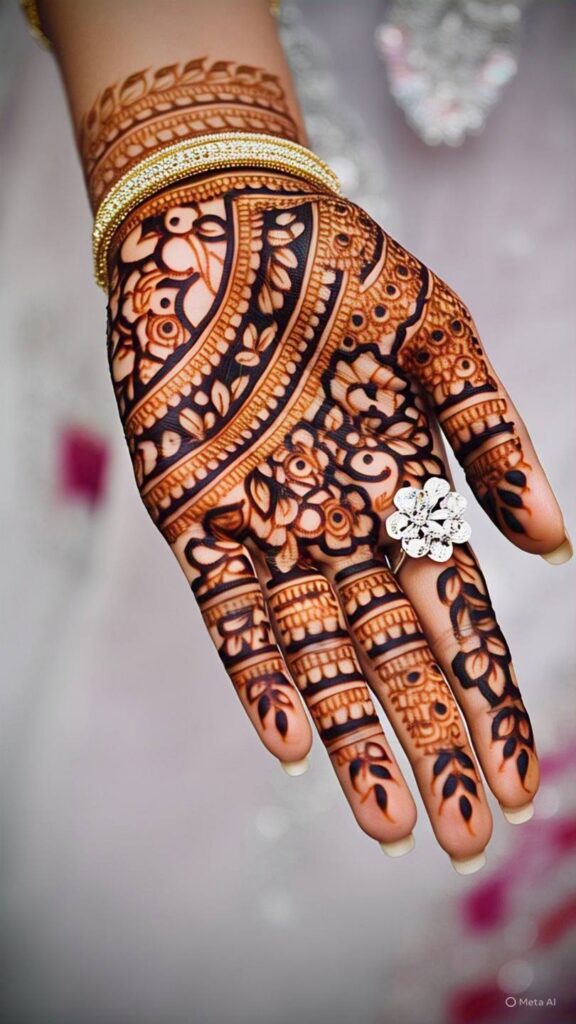
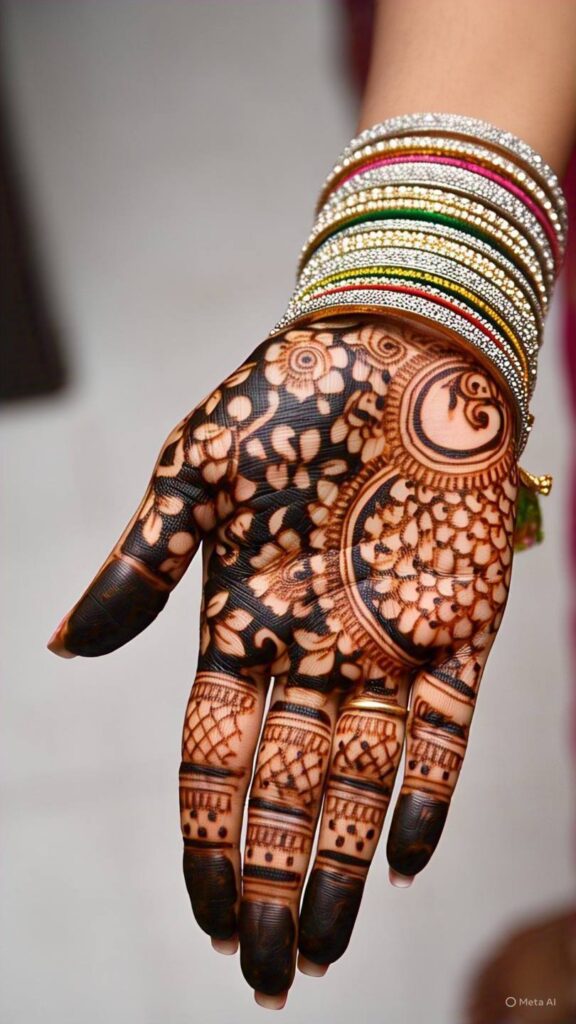
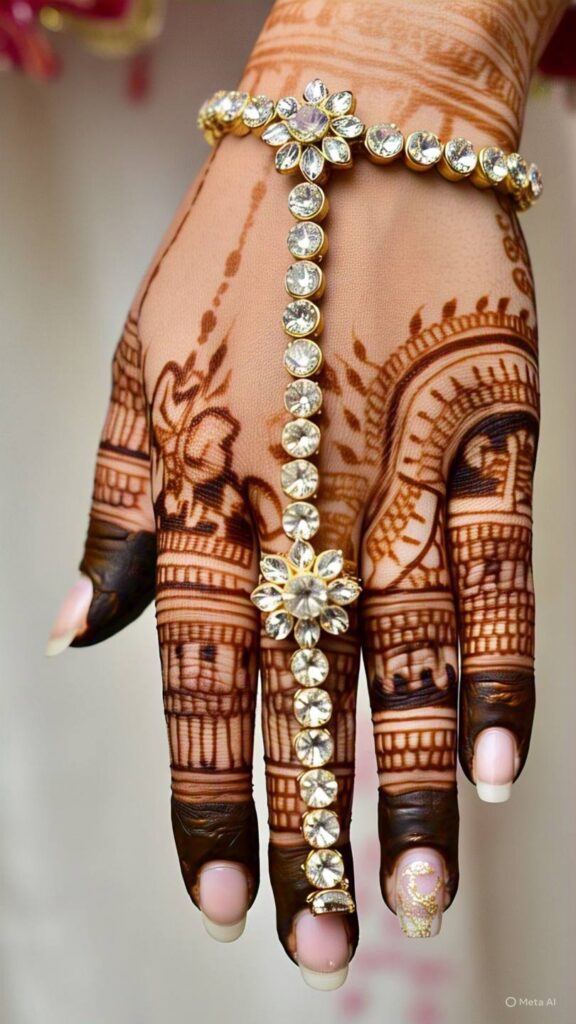
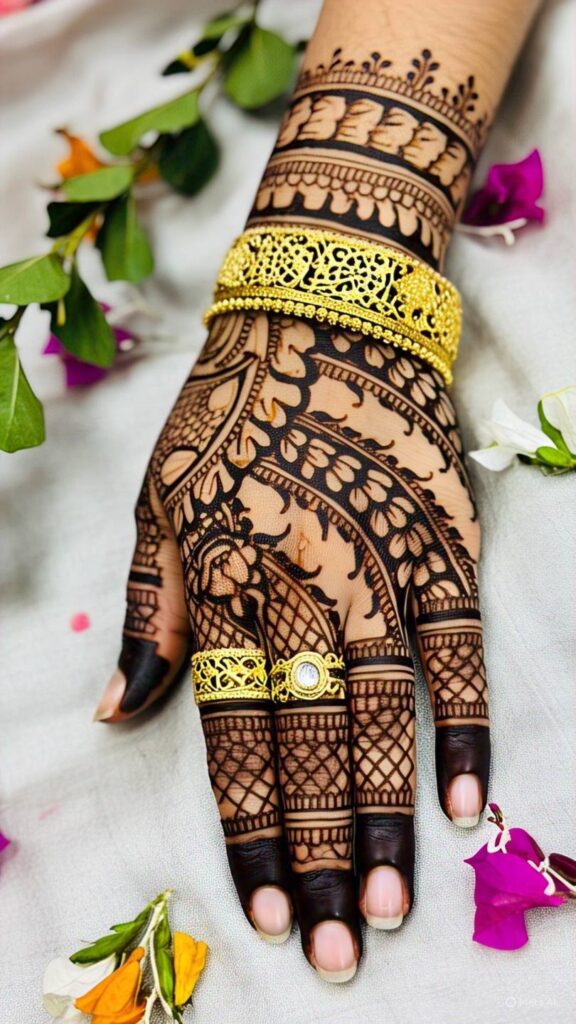
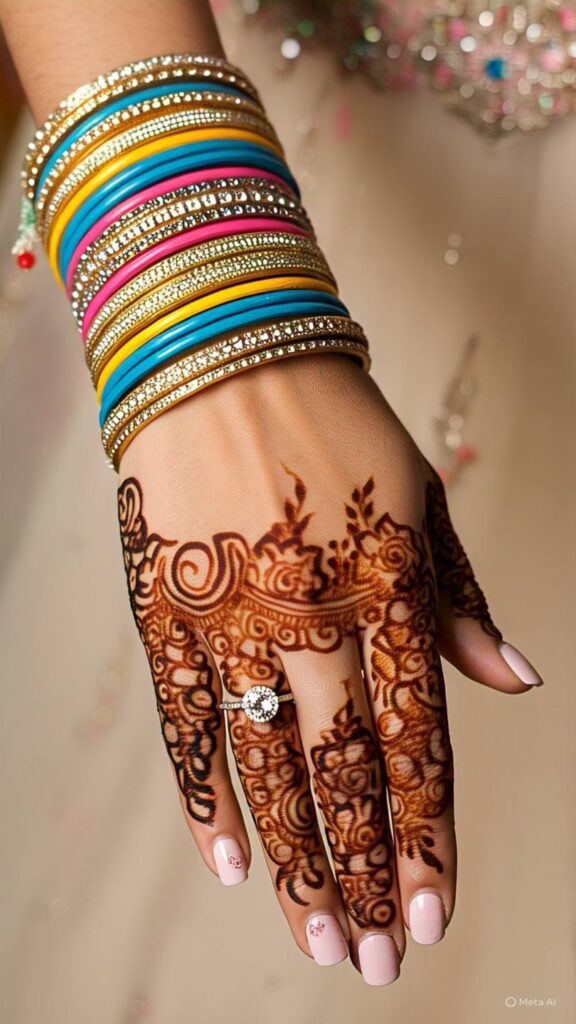
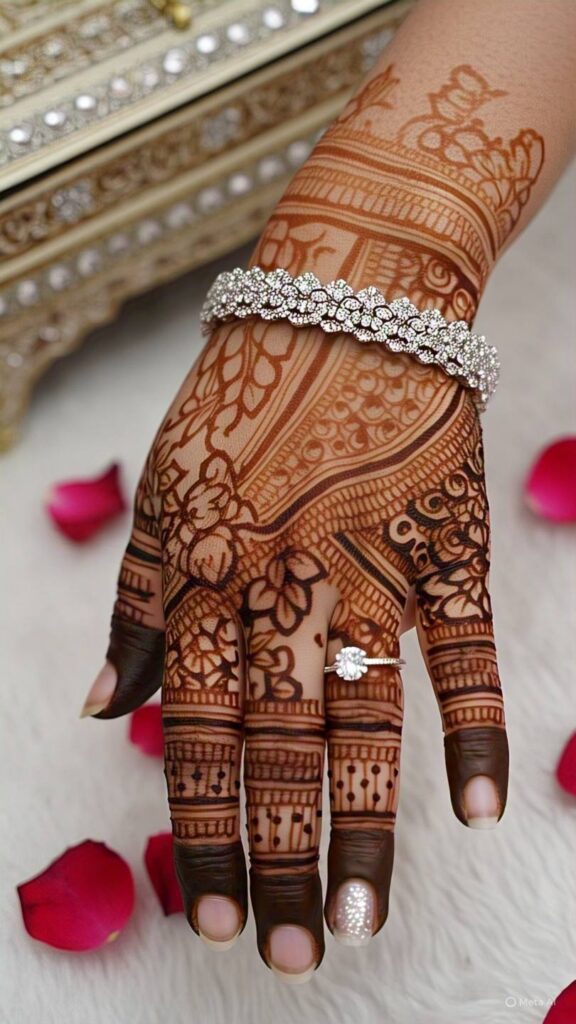
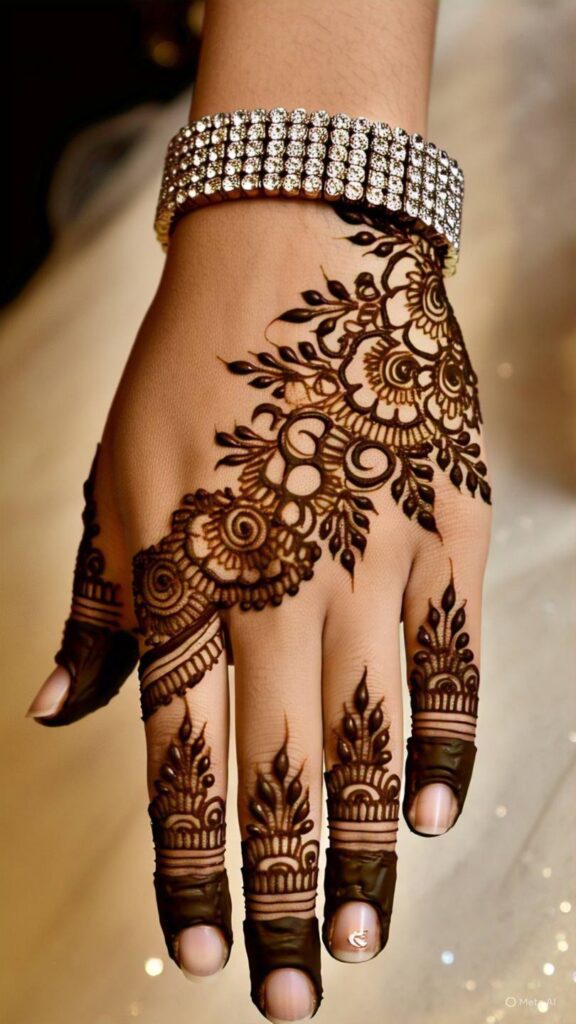
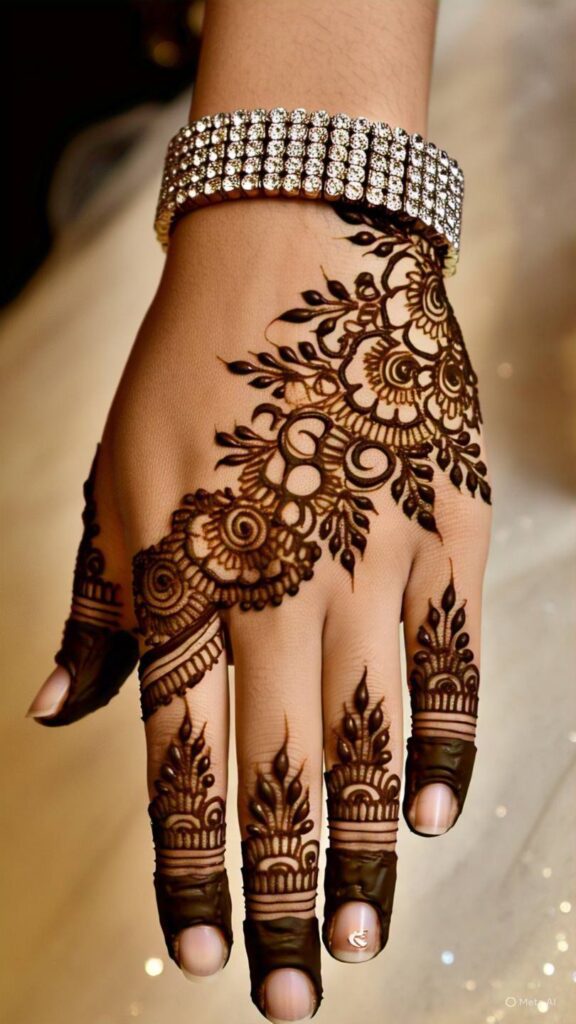
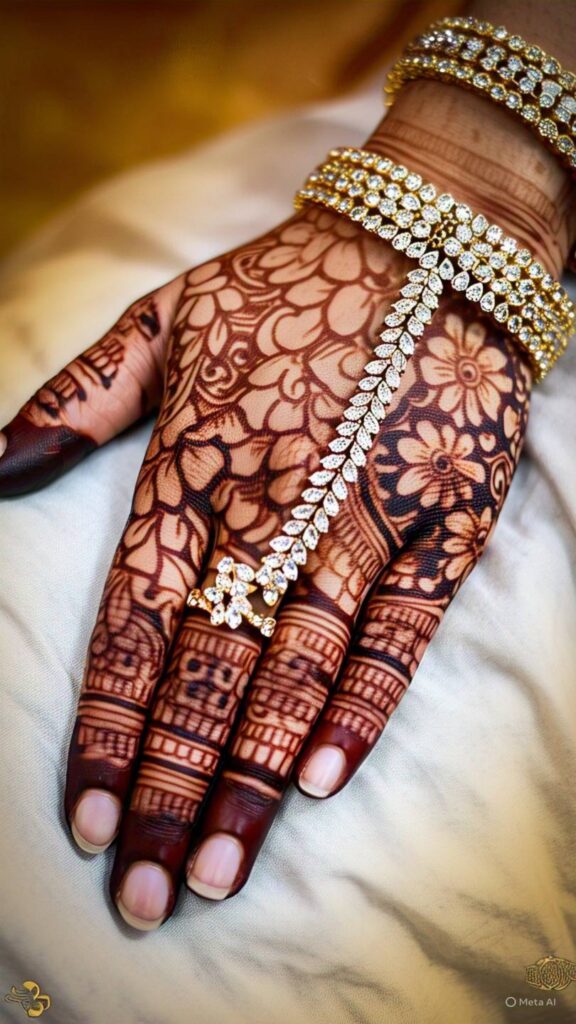





























































The Significance of Left-Hand Mehndi Design
Mehndi is an ancient art form of henna decoration that has a very special place within many cultures. This holds for weddings, festivals, and other festive events. Left-hand Mehndi Design has its symbolic meaning and aesthetic appeal. This guide will explore the art of left-hand mehndi, from the front left-hand design to the back left-hand design, and all the variations in between. It includes professional tips, trendy motifs, as well as meaningful inspirations to help you choose the right pattern.
In some traditions, the mehndi left-hand design can be considered auspicious. The left hand is a symbol of receptivity and emotional depth. It can also represent hidden beauty. You can highlight themes such as femininity, grace, and reflection by choosing a design focused on the left hand.
Many women, from an aesthetic perspective, prefer to have a more intricate left-hand mehndi front– the area of the palm that’s visible when greeting or offering– while keeping the left-hand mehndi back more delicate and complementary. The balance of the design ensures the hand is the focal point while the back side adds elegance and sophistication without being overpowering.
Designing the Front of the Palm: Left Hand Mehndi Design Front
The left-hand mehndi front is the place where creativity shines. As the palm is the part that’s most visible during greetings and blessings, it often becomes the focal point of a mehndi design. These are the latest motifs.
- Floral Mandala Designs: Mandalas placed on the palm create symmetry and symbolism. The petals radiate inwards, symbolizing growth and unity. This is ideal for your front left hand.
- Peacock Motifs: A peacock’s ornate feathers and curved neck are adapted to a palm-shaped design that conveys elegance and regal beauty. The motifs used in bridal mehndi are especially popular.
- Paisley & Floral Fusion: The central design is surrounded by delicate flowers, creating a timeless and balanced look.
Plan your layout by considering how the theme flows out from the middle of the palm. The palms have a lot of expression. Raised just a little, they attract attention instantly. When choosing or designing a pattern, keep this in mind.
Creating Harmony with the Left Back Hand Mehndi Design
While the front of the palm art is the focus, the left back hand mehndi designs, which touch the wrist, thumb, and the back of the hand, complement the design. The area is perfect for adding flowing vines or lace-like netting. You can also add tiny florals and connecting dots to bind together the wrist pattern with the palm design.
Popular styles include:
- Lace & Netting: Fine, delicate patterns, with small dots placed in every space.
- Leaves and Florals Small floral motifs scurrying up the wrist from base to tip of fingers.
- Wraparound Vine: A vine that wraps around the wrist and connects to the palm motif centrally. This is a subtle but cohesive touch.
- Finger Accents: The small spirals, dots, and florals in the design on the left-back hand are incorporated into the pattern.
Balance is the key. Your front hand may grab the attention, but the back design will keep the eye moving naturally.
Designing the Left Hand Mehndi Design Back (Full Reverse View)
You can also extend your creativity to the back of your left hand mehndi–wrist up through the forearm. This is a great canvas for style. This area is perfect for dramatic accents, even though smaller ones are lovely.
- Geometric patterns: Modern and attractive geometric shapes such as triangles, chevrons, and rhombuses in rhythmic repetition.
- Indian Motifs: Mandalas and temple arches remind us of cultural stories. Elephants or peacocks are also depicted.
- Designs for Brides: Reverse hand art is often used by brides to include the groom’s initials, dates, or special symbols. It creates a personalized symbolism.
- Arabic Inspired Swirls: The bold, sweeping curves of the vines contrast beautifully with the front palm detail.
Left Hand Mehndi Design Back is often accentuated with jewelry such as bracelets and bangles. Make sure your mehndi does not compete with accessories. Instead, they should complement each other. Coordinate patterns with wrist ornaments for a coordinated look.
Tips for Choosing the Perfect Left-Hand Mehndi Design
Match Your Occasion
- Weddings: The brides combine front and back patterns to create full-hand coverage.
- Festivities & Celebrations: Make it simple and elegant with single flowers and vines.
- Casual Clothing: Simple designs with finger dots and a wrist accent are suitable for everyday wear.
Consider Your Hand Shape
- Narrow Palms and Long Fingertips Use vertical patterns to visually elongate palms.
- Wide palms: The design is shaped nicely by the central motif (mandalas, peacocks).
- Thicker Wrist Bands or Cuff Designs: Thick wrist bands and cuffs stretch elegantly across the wrist to balance proportions.
Know Your Colours
- Mahendi Classic Tone: A deep reddish brown derived from traditional pastes and lime-sugar settings.
- Modern Black Mehndi offers a dramatic contrast, but be careful to use it sparingly on fresh skin cuts. It can stain the skin darker.
- Julia Design: For temporary white body art lovers, white or pastel henna is the latest trend. It adds uniqueness to the Left Hand Mehndi Design.
Prep and After-care
- Wash Hands: Before starting, wash your hands well.
- Seal the design with Lemon-Sugar. Once the mehndi has dried, add a little sugar-lime to the pattern.
- Leave it to Set: For best results, leave the cone in place for 6-8 hours.
- Peel but don’t wash. Remove the henna by gently peeling it off and keeping your hands dry.
- Do not use heat or moisture. These will naturally darken the mehndi in 48 hours.
Step-by-Step Guide for a Left-Hand-Only Session
- Follow these steps, whether you are alone or with someone else:
- Draw Your Main Motive. Use a pencil and lightly outline a mandala on your palm.
- Start with an eye-catching focal point: Begin by focusing on your primary motif, which is usually the center of the palm or the back. Most artists begin their work at the palms for better control.
- Continue to Wrist and Back. After the front has been completed, you can mirror the design or add geometric or vine lines or vines on the back of the left-hand mehndi design.
- Send accents to fingers: Small dots, spirals, and motifs on the fingertips bind together front and back designs.
- Wrist Cuff: Add a lace cuff or tribal band to the wrist.
- Sealing and Aftercare: Allow to dry and seal with sugar-lime.
Trendy Ideas for 2025 Left-Hand Designs
These trends influence the left-hand art of mehndi.
- Minimalist floral: Simple daisy bunches, vine work, and white space are popular with modern brides.
- Personalized Symbols: Incorporate initials, love birds, lock & key motifs, or dates into your left back hand mehndi design–subtle, yet meaningful.
- Fusion styles: Combining Arabic swirls and Indian dots on the palm to give a new twist to tradition.
- Reversed Hand Work: Many modern brides choose light-colored palms with reversed handwork that is detailed. This works well for wrist jewelry, bangles and other elegant accessories.
Inspiration for All Looks
- Traditional Bridal Look: A central mandala on the palm, peacock on the wrist, lace cuffs on the wrist, finger accents, and tiny dots trailing to the back of your hand—perfect harmony across all areas.
- Festive Simplicity: Small floral mandala front, vine slip over, and a cuff band across the wrist. Clean yet festive.
- Everyday Elegance: Single flower on palm, delicate vine bypassing the back, and a matching bracelet accent design at the wrist.
- Photo-Ready Fusion: Fulfill modern wedding aesthetics with a bold geometric bracelet band over the wrist, minimalist palm design, and Arabic vine spiral on the left back-hand mehndi design.
Choosing the Right Artist
Specify your requirements clearly when working with mehndi artists:
- You can also use the front left mehndi design to draw attention.
- Ask for a wristband that complements the mehndi left-hand design to ensure it doesn’t become obscured.
- You may want to ask for examples of previous mehndi designs done on the left-hand side.
- Decide if you want to create dense designs or modern, airy ones.
Choosing Between Full or Partial Left-Hand Designs
- DIY: Ideal for those who prefer simple patterns. Create a left-hand accent and front using stencils. These are great for creating finger trails, delicate wrist vines, or cuffs.
- Salon Expert: Perfect for bold or bridal designs (full-reverse-hand, symbolism). Salon artists can create symmetrical designs, swirls, and free-hand mandalas with ease.
DIY vs Salon Mehndi
- DIY: Ideal for those who prefer simple patterns. Create a left-hand accent and front using stencils. These are great for creating finger trails, delicate wrist vines, or cuffs.
- Salon Expert: Perfect for bold or bridal designs (full-reverse-hand, symbolism). Salon artists are able to create symmetrical designs, swirls, and free-hand mandalas with ease.
Aftercare Tips Recap
- Once dry, seal with sugar-lime.
- Allow it to sit 6-8 hours.
- Peel the label (don’t immediately wash).
- Darken the design by applying light oil.
- Do not soak for more than 24 hours.
Also Read: leg mehndi design
Mehndi is an ancient art form of henna decoration that has a very special place within many cultures. This holds for weddings, festivals, and other festive events. Left-hand Mehndi Design has its symbolic meaning and aesthetic appeal. This guide will explore the art of left-hand mehndi, from the front left-hand design to the back left-hand design, and all the variations in between. It includes professional tips, trendy motifs, as well as meaningful inspirations to help you choose the right pattern.
In some traditions, the mehndi left-hand design can be considered auspicious. The left hand is a symbol of receptivity and emotional depth. It can also represent hidden beauty. You can highlight themes such as femininity, grace, and reflection by choosing a design focused on the left hand.
Many women, from an aesthetic perspective, prefer to have a more intricate left-hand mehndi front– the area of the palm that’s visible when greeting or offering– while keeping the left-hand mehndi back more delicate and complementary. The balance of the design ensures the hand is the focal point while the back side adds elegance and sophistication without being overpowering.
Designing the Front of the Palm: Left Hand Mehndi Design Front
The left-hand mehndi front is the place where creativity shines. As the palm is the part that’s most visible during greetings and blessings, it often becomes the focal point of a mehndi design. These are the latest motifs.
- Floral Mandala Designs: Mandalas placed on the palm create symmetry and symbolism. The petals radiate inwards, symbolizing growth and unity. This is ideal for your front left hand.
- Peacock Motifs: A peacock’s ornate feathers and curved neck are adapted to a palm-shaped design that conveys elegance and regal beauty. The motifs used in bridal mehndi are especially popular.
- Paisley & Floral Fusion: The central design is surrounded by delicate flowers, creating a timeless and balanced look.
Plan your layout by considering how the theme flows out from the middle of the palm. The palms have a lot of expression. Raised just a little, they attract attention instantly. When choosing or designing a pattern, keep this in mind.
Creating Harmony with the Left Back Hand Mehndi Design
While the front of the palm art is the focus, the left back hand mehndi designs, which touch the wrist, thumb, and the back of the hand, complement the design. The area is perfect for adding flowing vines or lace-like netting. You can also add tiny florals and connecting dots to bind together the wrist pattern with the palm design.
Popular styles include:
- Lace & Netting: Fine, delicate patterns, with small dots placed in every space.
- Leaves and Florals Small floral motifs scurrying up the wrist from base to tip of fingers.
- Wraparound Vine: A vine that wraps around the wrist and connects to the palm motif centrally. This is a subtle but cohesive touch.
- Finger Accents: The small spirals, dots, and florals in the design on the left-back hand are incorporated into the pattern.
Balance is the key. Your front hand may grab the attention, but the back design will keep the eye moving naturally.
Designing the Left Hand Mehndi Design Back (Full Reverse View)
You can also extend your creativity to the back of your left hand mehndi–wrist up through the forearm. This is a great canvas for style. This area is perfect for dramatic accents, even though smaller ones are lovely.
- Geometric patterns: Modern and attractive geometric shapes such as triangles, chevrons, and rhombuses in rhythmic repetition.
- Indian Motifs: Mandalas and temple arches remind us of cultural stories. Elephants or peacocks are also depicted.
- Designs for Brides: Reverse hand art is often used by brides to include the groom’s initials, dates, or special symbols. It creates a personalized symbolism.
- Arabic Inspired Swirls: The bold, sweeping curves of the vines contrast beautifully with the front palm detail.
Left Hand Mehndi Design Back is often accentuated with jewelry such as bracelets and bangles. Make sure your mehndi does not compete with accessories. Instead, they should complement each other. Coordinate patterns with wrist ornaments for a coordinated look.
Tips for Choosing the Perfect Left-Hand Mehndi Design
Match Your Occasion
- Weddings: The brides combine front and back patterns to create full-hand coverage.
- Festivities & Celebrations: Make it simple and elegant with single flowers and vines.
- Casual Clothing: Simple designs with finger dots and a wrist accent are suitable for everyday wear.
Consider Your Hand Shape
- Narrow Palms and Long Fingertips Use vertical patterns to visually elongate palms.
- Wide palms: The design is shaped nicely by the central motif (mandalas, peacocks).
- Thicker Wrist Bands or Cuff Designs: Thick wrist bands and cuffs stretch elegantly across the wrist to balance proportions.
Know Your Colours
- Mahendi Classic Tone: A deep reddish brown derived from traditional pastes and lime-sugar settings.
- Modern Black Mehndi offers a dramatic contrast, but be careful to use it sparingly on fresh skin cuts. It can stain the skin darker.
- Julia Design: For temporary white body art lovers, white or pastel henna is the latest trend. It adds uniqueness to the Left Hand Mehndi Design.
Prep and After-care
- Wash Hands: Before starting, wash your hands well.
- Seal the design with Lemon-Sugar. Once the mehndi has dried, add a little sugar-lime to the pattern.
- Leave it to Set: For best results, leave the cone in place for 6-8 hours.
- Peel but don’t wash. Remove the henna by gently peeling it off and keeping your hands dry.
- Do not use heat or moisture. These will naturally darken the mehndi in 48 hours.
Step-by-Step Guide for a Left-Hand-Only Session
- Follow these steps, whether you are alone or with someone else:
- Draw Your Main Motive. Use a pencil and lightly outline a mandala on your palm.
- Start with an eye-catching focal point: Begin by focusing on your primary motif, which is usually the center of the palm or the back. Most artists begin their work at the palms for better control.
- Continue to Wrist and Back. After the front has been completed, you can mirror the design or add geometric or vine lines or vines on the back of the left-hand mehndi design.
- Send accents to fingers: Small dots, spirals, and motifs on the fingertips bind together front and back designs.
- Wrist Cuff: Add a lace cuff or tribal band to the wrist.
- Sealing and Aftercare: Allow to dry and seal with sugar-lime.
Trendy Ideas for 2025 Left-Hand Designs
These trends influence the left-hand art of mehndi.
- Minimalist floral: Simple daisy bunches, vine work, and white space are popular with modern brides.
- Personalized Symbols: Incorporate initials, love birds, lock & key motifs, or dates into your left back hand mehndi design–subtle, yet meaningful.
- Fusion styles: Combining Arabic swirls and Indian dots on the palm to give a new twist to tradition.
- Reversed Hand Work: Many modern brides choose light-colored palms with reversed handwork that is detailed. This works well for wrist jewelry, bangles and other elegant accessories.
Inspiration for All Looks
- Traditional Bridal Look: A central mandala on the palm, peacock on the wrist, lace cuffs on the wrist, finger accents, and tiny dots trailing to the back of your hand—perfect harmony across all areas.
- Festive Simplicity: Small floral mandala front, vine slip over, and a cuff band across the wrist. Clean yet festive.
- Everyday Elegance: Single flower on palm, delicate vine bypassing the back, and a matching bracelet accent design at the wrist.
- Photo-Ready Fusion: Fulfill modern wedding aesthetics with a bold geometric bracelet band over the wrist, minimalist palm design, and Arabic vine spiral on the left back-hand mehndi design.
Choosing the Right Artist
Specify your requirements clearly when working with mehndi artists:
- You can also use the front left mehndi design to draw attention.
- Ask for a wristband that complements the mehndi left-hand design to ensure it doesn’t become obscured.
- You may want to ask for examples of previous mehndi designs done on the left-hand side.
- Decide if you want to create dense designs or modern, airy ones.
Choosing Between Full or Partial Left-Hand Designs
- DIY: Ideal for those who prefer simple patterns. Create a left-hand accent and front using stencils. These are great for creating finger trails, delicate wrist vines, or cuffs.
- Salon Expert: Perfect for bold or bridal designs (full-reverse-hand, symbolism). Salon artists can create symmetrical designs, swirls, and free-hand mandalas with ease.
DIY vs Salon Mehndi
- DIY: Ideal for those who prefer simple patterns. Create a left-hand accent and front using stencils. These are great for creating finger trails, delicate wrist vines, or cuffs.
- Salon Expert: Perfect for bold or bridal designs (full-reverse-hand, symbolism). Salon artists are able to create symmetrical designs, swirls, and free-hand mandalas with ease.
Aftercare Tips Recap
- Once dry, seal with sugar-lime.
- Allow it to sit 6-8 hours.
- Peel the label (don’t immediately wash).
- Darken the design by applying light oil.
- Do not soak for more than 24 hours.
Also Read: leg mehndi design

